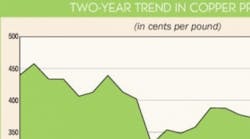When Electrical Wholesaling's editors looked over their favorite economic indicators for the electrical market, they were surprised by how many of the monthly indicators were dead-on in reflecting the general mood of the industry. On the surface, copper pricing and data that measures electrical manufacturers' shipments and what purchasing managers and architects are seeing in their businesses might not seem to have too much in common. But these and other indicators all showed the same thing — early optimism in 2012's first quarter that continued ramping up until about mid-year before wilting with the summer heat.
This malaise has continued for most of the second half of the year. It's tough to say exactly what caused it, although most economists think concerns over the presidential election and the fiscal cliff are largely responsible. But if Congress gets its act together and avoids the fiscal cliff and concerns over Obama's re-election fade enough that business owners are willing to reinvest in their businesses, 2013 could turn out to be better than expected, and as you will see in this article, growth could really accelerate in 2014-2015.
Next year could be better than expected if the malaise dissipates, because the recovery in housing markets is spreading quickly metro-by-metro; office vacancy rates are declining on a national basis and will spark demand for new offices; and the industrial MRO market should provide some steady if unspectacular growth. Throw in some good growth in the energy markets because of the big-time growth in oil-related business of the Bakken region in North Dakota and the Marcellus Shale deposit in New York, Ohio and Pennsylvania, plus consistent demand for basic lighting retrofits, and on a national basis electrical distributors' sales could easily exceed the 4.4% that Electrical Wholesaling forecast in its 2013 Market Planning Guide.
The data in this article should prove more valuable than the general economic forecasts you find in the business pages of most newspapers, because it focuses more on retail sales, consumer spending and macroeconomic information rather than on data that directly affects the electrical market.
Copper Pricing
Source: U.S. Geological Survey, MetalsWeek and www.metalprices.com
Copper pricing didn't live up to its reputation for volatility in 2012, as it spent most of the year moving sideways. The red metal spent much of 2012 in a 40-cent range from $3.30 to $3.70 per pound. As in 2011, the $3 level seems to be the floor in the “new normal.” Prices haven't dipped below $3 per pound since 4Q 2009, and over the past two years they haven't changed much at all. Electrical Marketing's Electrical Price Index shows that through October building wire was down 8% YTY and power wire and cable was up 3.1%
Total Construction
Source: McGraw-Hill's 2013 Construction Outlook
The different segments of the construction market march to the beat of their own drummers, but who would have thought housing would be the strongest segment in 2012? According to McGraw-Hill's forecasts, total construction rose 5% in 2012 to $457.9 billion and is expected to rise 6% next year to $483.7 billion, but single-family housing was up 27% to $123.5 billion in 2012 and is forecast to grow by 24% in 2013. McGraw-Hill also predicts a sharp increase in commercial buildings with a 12% boost to $55.9 billion.
Electrical Contractor Employment
Source: Bureau of Labor Statistics
Electrical contractor employment is finally moving in the right direction and is up approximately 5% since January to 737,700 employees in September. But it's still a little wobbly, as the most recent YTY numbers haven't moved much. Electrical contractors account for an estimated 36% of all electrical products sold through electrical distributors, so any increase makes a huge difference. Distributors sell $34.3 billion in goods to contractors, which is nice but still well below EW's estimates for $40 billion plus in sales five years ago.
Electrical Manufacturers' Shipments
Source: U.S. Department of Commerce
This indicator always seems to do a pretty good job of catching the mood of the electrical market. Shipments started the year strong but then tailed off at mid-year when the concerns started to set in about the outcome of the presidential election and the fiscal cliff. The approximately $3 billion in monthly sales for Sept. 2012 shows some downward momentum, dropping 1.2% YTD and 1.8% YTY. Compared with the previous market high, shipments are down 26% from Aug. 2008, when they topped out at a monthly number of $3.8 billion.
AIA's Architecture Billings Index (ABI)
Source: American Institute of Architects
This measure has gotten popular in recent years, as anyone involved with the sale of construction-related products wants to get an early read on what architects see down the road. Because they are involved in the earliest stages of the construction process, tracking their inquiries and billings provides an indicator that leads construction activity by approximately nine- to 12 months. Inquiries and billings are both tracking ahead of the 50-point mark indicating a growth climate, and are showing some decent momentum both YTY and YTD.
Housing Starts
Source: National Association of Home Builders (NAHB)
Housing starts still have ways to go, but they are certainly headed in the right direction. NAHB is forecasting a 21% increase in single-family starts this year to 528,000 units and a further 26% climb to 665,000 units in 2013. The association says multi-family housing starts are expected to rise 26% this year to 224,000 units and 6% in 2013 to 238,000 units. Mark Zandi, chief economist for Moody's Analytics, expects 1.1 million total housing starts in 2013, 1.7 million to 1.8 million in 2014 and more than 1.8 million in 2015.
Dodge Momentum Index
Source: McGraw-Hill Construction
Here's a new leading indicator that offers a monthly measure of the initial reports for nonresidential building projects in planning, which lead construction spending for nonresidential buildings by a full year. The most recent numbers show a decline, as the Dodge Momentum Index retreated to 93.3 (2000=100) in October, the third consecutive monthly decline following the most recent peak of 96 points in July. McGraw-Hill says the recent loss of momentum can be attributed in part to uncertainty about the U.S. presidential election and the looming fiscal cliff.
















